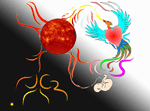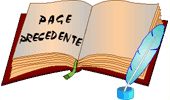«The child is without prejudice, the first quality
of a great philosopher.
He perceives the world as it is, without a priori ideas that distort our adult vision.» Jostein Gaarder. |
The birth
of the healthy mind.
of the healthy mind.
6 - The consciousness of the child :
A - Primordial brain and immaterial thoughts :
After 30 weeks of pregnancy, an important network linking various structures is at work in the fetal brain. A few weeks later, in the newborn, these areas are almost completely formed. They correspond to those that adults use spontaneously when they let their minds wander. They also correspond to the areas of the brain that are used during introspection and daydreaming.This mode of operation, which occurs while the child's brain is being structured, could help us to understand how the adult's consciousness is constructed.
We have seen the predispositions of the very young in physics, biology and mathematics. The early development of these cerebral regions which will later enable him to think about himself and explore the past and the future, already indicates, in the newborn, the capacity to reason in the absence of any material support.
Where does this ability come from ?
Today, the gap that separated humans from the great apes and other primates is gradually closing [in french].
The ability to recognise oneself in a mirror, considered to be the mark of self-awareness, was previously attributed to humans, great apes (chimpanzees, orangutans, bonobos, gorillas), elephants and dolphins. Today, it is known that the rhesus macaque also possesses this capacity, and researchers no longer consider that there is a cognitive gap between this elite group and the other mammals : they recognise a continuous transformation of the mental functions of the species in the course of evolution.
Thus, the consciousness of the child appears to be the result of an evolutionary process that seems to begin with the appearance of the animal kingdom is found at its most advanced stage in primates.
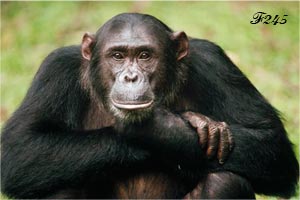
What benefit does the brain activity, discussed above, bring to the child's development of consciousness ?
Difficult to grasp in the child who is not yet speaking, this capacity can be better understood in the adult : letting his thought wander freely allows him to explore all the notions he has previously acquired.
The brain's natural capacity for analogical reasoning can then be freely expressed : if we do not have an immediate explanation for an incomprehensible phenomenon, we can compare it with another known phenomenon. This is how the atom has been compared to a planet surrounded by its satellites or to the solar system.
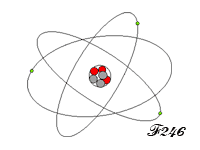 |
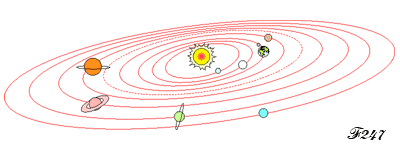 |
This is how the structure of the atom, inspired by knowledge of our solar system, could be clarified by all the data of theoretical physics, before being proven.
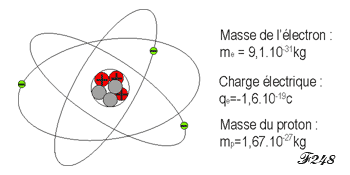 |
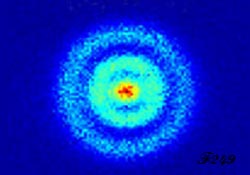 |
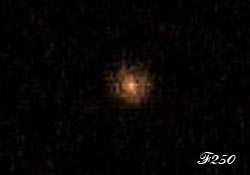 |
« Mental functions evolve continuously
in the course of the evolution of species. »
in the course of the evolution of species. »
Where does this thought that is exercised in the absence of any support come from ?
B - The child's super-consciousness :
a - The consciousness of the adult :An experiment undertaken under the direction of Geraint Rees (University College London) was conducted with 32 people. They were asked to discern the most contrasting pattern among other striped patterns presented on a screen. They were then asked to rate, from 1 to 6, the degree of confidence they had in their answers.
These, compared with fMRI images of their brains taken during the experiment, showed that the anterior prefrontal cortex is more developed and more connected to other areas of the cortex in the more confident subjects, indicating the collection of as much information as possible.
The exercise of introspection, which consists of gathering as much data as possible in order to be sure of one's judgement, can therefore lead to variable results.
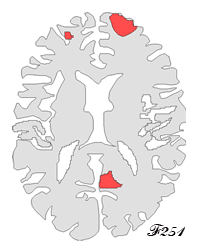
However, if it is indeed the anterior prefrontal cortex which will determine the final choice, it is not for this reason that it can be designated as the seat of consciousness in the brain.
b – How do babies see the world ?
The way psychologists look at children under the age of three has also changed radically [cf. Piaget] in recent decades...
Where the psychologist Jean Piaget had concluded that cognitive capacities were limited, researchers at the end of the 20th century have instead discovered :
- An innate capacity for arithmetic calculation,
- The implementation of statistical sorting,
- The ability to extract rules of cause and effect between different phenomena.
What is the difference between Piaget and current researchers ? The ability to have as much reliable data as possible to arrive at a sound judgement. The researchers of Jean Piaget's time had little more than their intuitions and common sense to advance knowledge.
While certain cognitive functions - sensory, motor, associative, memory - depend on the development of the brain and only become operational after a certain age, their overall harmonisation evolves continuously from birth to adulthood. However, knowing a child's innate abilities did not previously allow access to his or her thoughts. Today, this knowledge is possible.
For Alison Gopnik (professor of psychology at the University of California, Berkeley), the reason why children are so fascinated by the world around them is that they are in contact with reality in an incredibly stronger and more direct way than adults.
Anchored in a present that they are constantly discovering, they do not project themselves into an improbable future and see things that adults have lost sight of.
The experiment also shows what is specific about children's attention : it is influenced more by external events than by their own will.
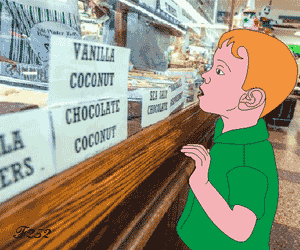
They only show their ability to be interested in what is around them, to discover and learn.
This is also the behaviour of researchers who are always on the lookout to discover, learn and understand...
Thus, one could say that this mode of behaviour is the very culmination of the evolution of cognitive abilities in the animal kingdom : discovering the world and adapting to it in order to survive.
« The baby's thinking is exercised without a frontal filter. »
c – How does the baby access the world ?
One of the experiments that helped to answer this question consisted in presenting a series of two cards to children and asking them to choose only one (the one on the left, for example).
They were then asked not only about the card presented, but about both...
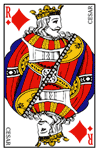 |
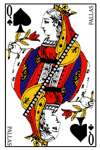 |
- the smallest children were less good than their elders at remembering the initial card.
- But they were better at remembering the right-hand card, which they were not supposed to remember.
Thus the child, driven by curiosity, is not particularly inclined to be influenced by others. Able to observe everything around him, he will more easily memorise what attracts him. If he wonders, his question would be: "these two cards are similar, what is so special about the one on the right that I shouldn't memorise it ?
Later, after he has learned to follow the adults' directions, he will try to memorise what has been suggested to him. He will no longer see the whole picture, but only the elements to which his attention has been drawn.
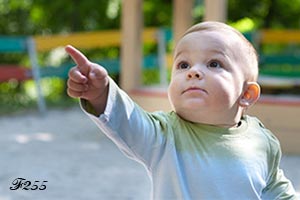
I see first what interests me.
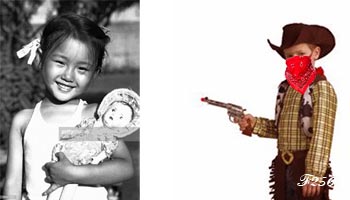
I now see what I have to be interested in.
... He will then have acquired the vision of the group...
Thus, only children show themselves capable of seeing, and if they maintain their own worldview, it is they who will evolve the collective thinking. Moreover, are they not the ones who, in adolescence, rebel when society forces them to see only part of reality? In many circumstances, they are the first to fight against injustice and to become aware of real needs.
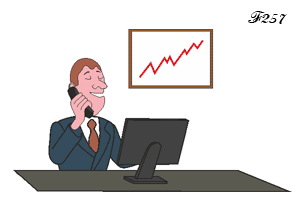 |
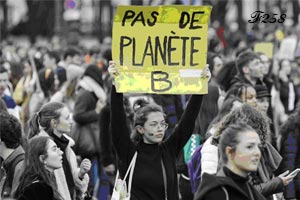 |
- To fit into the mould and see only one side of reality,
- To rebel and oppose everything,
- Maintaining a vision of the whole of reality and making the best choice to transform the world and secure their future.

Self-interest...

...Ignorance of the other...
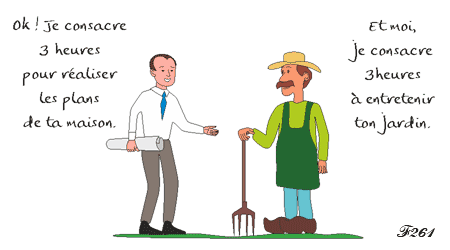
...or sharing.
This experience of memorising cards shows the inability of the smallest children to maintain their attention on a suggested goal.
The toddler's attention is guided above all by novelty. This attention also feeds their memory.
In 2004, psychologist Robyn Firrish from Emory University in Atlanta analysed the behaviour of two-year-olds walking through a zoo with their mother.
A few days later, the mother asked her child to tell her what they had done.
The psychologist found that if the children can describe certain events (an action of the elephant, for example), it is almost always an echo of what their mother has said during the visit. This may be related to the trust that the child has in his mother [see : Learning through trust]: by doing so, he also strengthens the emotional bond with her.
If she has not paid attention to the elephant during this visit, the child will not talk about it.
If the toddler's curiosity is open to everything around him, we also know that he trusts those around him to know what is important to remember. Thus, by taking an interest in the zoo, and in animals that he does not yet know, he will not choose one of them on his own. It is his mother's interest in the elephant that will cause him to notice it, because by doing so he strengthens the emotional bond with her.
The toddler's attention and memory thus seem to be built essentially on the basis of external events and the emotional bonds he establishes with others. Thus, as he develops his knowledge, he will also develop his bonds of belonging.
However, some researchers consider that his choices are not conscious.
This functioning allows us to understand how babies differ from adults: they discover things with their senses alone, whereas adults respond to two types of contradictory injunctions : those of their own sensitive nature and those of the society in which they live.
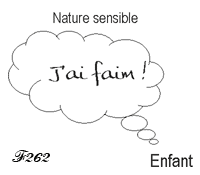

Adults often have to repress their feelings under collective pressure. The innate awareness of their needs and emotions will therefore fade and even seem to disappear in what is known as "The Unconscious". However, the latter will continue its work of recognition and analysis as it did during early childhood.
Would the child therefore be unconscious, that is to say incapable of being conscious like the adult?
Could it be preconscious, as other researchers such as Sid Kouider (a specialist in consciousness at the Laboratory of Cognitive Science and Psycho-Linguistics at the ENS) think: it would then be content to assimilate information from a very rich environment, without being able to process it efficiently in the absence of a mature prefrontal cortex.
What is certain is that his openness will enable him later to access adult consciousness to develop his discoveries and knowledge.
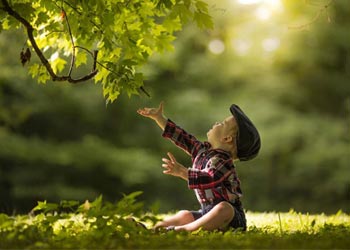
Open mind to the surrounding world...
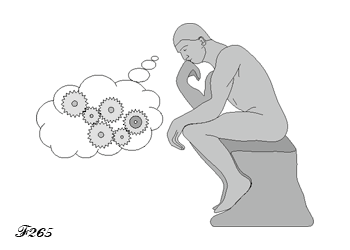
...and then open to reflection.
This is how the baby will be able to feel hunger, or the emotions of the other person, but without having knowledge of the mechanisms of hunger or satiety, or the reasons for the emotion experienced: it will need language for this.Will the education he receives extend his openness to the beauty and richness of the universe in which he lives, or will it lead him into dead ends?
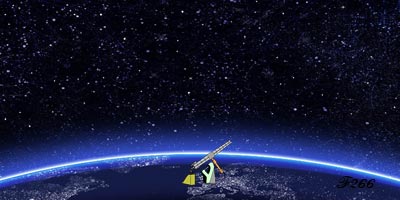
Discoveries through science...

...or the immediate solution.
C – The importance of the frontal cortex :
a - The importance of the frontal cortex :We know that, in the adult brain, the ability to focus attention depends on a particular area: the frontal cortex] which will process information while ignoring everything else, which implies a choice [see : The frontal cortex directs and focuses attention - in french].
But the frontal cortex does not achieve this immediately: it takes many years to mature. Thus, unable to make choices, the child's attention remains open to everything that appeals to the senses.
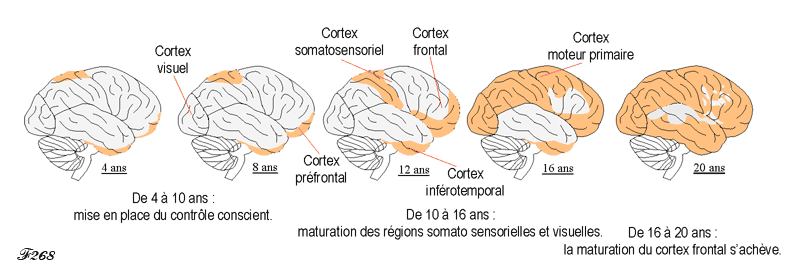
Maturation of the frontal cortex between the ages of 4 and 20.
How does the cortex mature?
- From 0 to 3 years: the brain is fully formed, but it must continue to develop. The brain regions will gradually interconnect. Sounds, images and other sensations create intense activity that the baby cannot control.
In fact, during this period, the frontal neurons are almost devoid of myelin, which facilitates the transmission of nerve impulses.
The influence of the frontal cortex is limited for this reason, and the brain's exploration of the surrounding world will be favoured.
- From 4 to 10 years : conscious control of information begins to take place, while synaptic connections are strengthened or lost according to needs and environmental conditions.
- 10-15 years: the brain regions that mature during this period are mainly the somato-sensory and visual regions.
- From 15 to 20 years: the frontal cortex, in charge of integrating complex information (reasoning, decisions, etc.), the bulk of which is dictated by the community, completes its maturation, ending with that of the dorsolateral prefrontal cortex, which is essential for maintaining attention.
During this long period, the production of new neurons is very important, as the frontal cortex is responsible for sorting out different behaviours.
It is around the age of 20 that behaviours will be determined and interests fixed: it will then become very difficult to go back and escape the acquired conditioning.
« The maturation of the frontal cortex, the seat of choice
and conscious control,
begins at age 4 and ends at age 20. »
and conscious control,
begins at age 4 and ends at age 20. »
D – The "extended" consciousness of children :
a - The child's mind ? A mind open to the world :
It is difficult to understand such a transformation of the way of thinking if we compare the consciousness of the adult with that of the child before the age of 3.
Thus, before the age of three, precisely because the frontal cortex cannot yet filter and prioritise information, the brain allows itself to be penetrated by sensory perceptions, emotions and memories... It is fully awake to life, and will remain so until education imposes other choices in the hierarchy of behaviours to adopt.
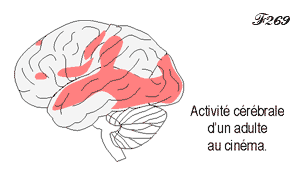
What can we compare this particular state to? One possibility was proposed in 2004 by Raphaël Malach, from the Weizmann Institute of Science (Israel). He recorded the brain activity of five adults during a feature film.
He found that, like babies, the frontal cortexes of these spectators were inactive : they all let themselves be carried away by the film, the images and the sounds.
This experiment is in line with Alison Gopnik's hypothesis of the expanded consciousness of very young children.
The child's mind is permanently open and in touch with reality alone. The deductions they make are primarily logical. As they do not yet have language, they do not allow themselves to be trapped in the contradictions of the adult.
The long period of immaturity of his frontal cortex allows him to develop his true personality in a concrete world from which the hubbub of adult interpretations is excluded.
Mutatis mutandis, the children's experiment can be compared to Einstein's 1887 experiment with 'detector silence'. At that time, science could not explain how electromagnetic waves could propagate in a vacuum, since every wave needed a material support. As the experiment to detect the existence of an 'ether' had failed, the way was clear to develop a new theory, that of relativity.
In the same way, the child can discover and learn in the first years of his or her life only by himself or herself, without any influence.
« Open-mindedness is the domain of the child. »
Yet, if we consider the idea that toddlers would be conscious, what consciousness could it be?
- Would it be the consciousness that philosophers call "access consciousness" which allows us to act rationally and which corresponds to the manipulation of information and its short-term memorization,
- Or would it be the one they call "phenomenal consciousness" which accounts for perceptual and emotional feelings ?
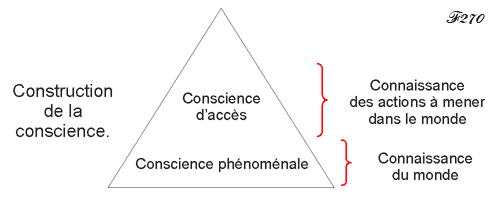
The construction of consciousness.
The form of attention that characterises children is closer to phenomenal consciousness than to access consciousness. Open to the real world, and carried by the richness of their sensitivity, it seems more accomplished than that of the adult, who is most often incapable of embracing the whole of reality.
Access consciousness, which characterises the adult, is built up over the years : it isthe result of focusing on a goal, a project. By excluding a large part of the information that does not concern the set objective, it becomes more precise and offers a greater capacity for action. But, by specialising in action, it loses the essence of what constitutes consciousness : openness to knowledge.
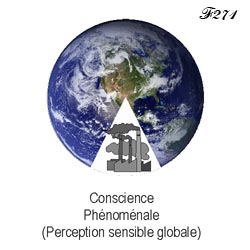 |
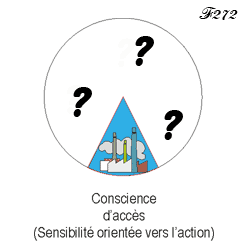 |
What is ! |
What can be done ! |
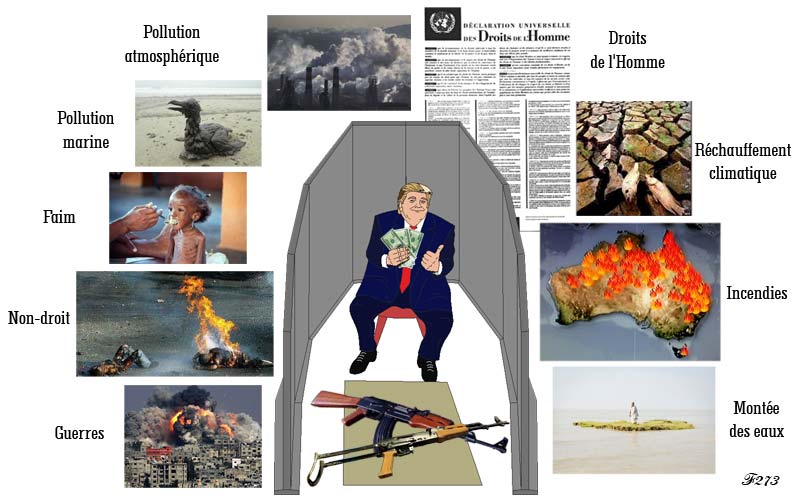
The focus of consciousness can exclude the essential.
Yet researchers are faced with a dead end... For the baby cannot express what it feels, and there is no way to measure it.
«Phenomenal consciousness is the result of sensitive perception.
It is the basis for the construction of access consciousness, which allows us to act with accuracy.»
It is the basis for the construction of access consciousness, which allows us to act with accuracy.»
b – The mind of the child? A mind similar to that of scientists :
We know that babies, from the first months of their lives, use statistics to acquire language. It is always thanks to them that they are able to develop hypotheses about the causes of an event [see : How do we see that the child is conscious?]
This indicates that they are not only aware of what they perceive, but that they are able to make inferences about facts that are beyond their immediate understanding. What they deduce is based on the reality of the facts and not on their imagination [see How babies see the world]
So, are babies scientists before their time ?
In 2002, psychologist Alison Gopnik of UC Berkeley conducted an experiment in which she asked three-year-olds to determine which of two cubes (one black and one white) caused a third cube to play music and emit light.

The machine started when the white block alone, or the white and black blocks, were placed on it.
Most children drew a logical conclusion: only the white block made the cube react.
In addition to this causal reasoning ability, Tamar Kushnir of Cornel University (USA) has shown that children as young as 20 months old use statistics to infer the preferences of others.
Asked to choose a toy to give to an adult, the children do so based on the adult's previous choices, which they have observed. If the adult has previously extracted several toys whose type is in the minority in the box, it is because he prefers it.
The child is therefore not only listening to the world, he is also listening to others, and in the conclusions he reaches there is only room for proven facts, those that will enable him to integrate and communicate safely in the world in which he has just been born.
c – The child's mind ? A mind capable of ordering the world :
If a draft occurs in a room full of objects, will it create order or disorder?
When do we discover that only agents with intention can order the physical world, and that the natural elements, when they exert their influence on objects, cause disorder instead?
Karen Wynn from Yale University in the United States and her team have shown that this ability appears before the age of one.
To do this, they studied the reactions of children aged 3 to 6.
They first showed them a picture of a character's room, Billy. Then they explained to half of them that Billy's sister had come into the room and moved things around, and to the other half that the wind had come in through the window.
They then presented the children with two pictures: one showed the room in order, the other showed it in disorder. The children were asked to indicate in each case who had caused the change: the wind or Billy's sister.
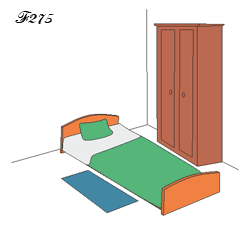 |
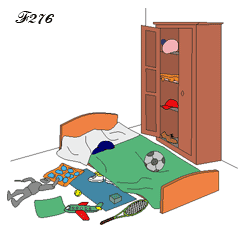 |
Eighty-eight per cent of the children's responses associated the mess with the wind, and 62 per cent associated the tidying with Billy's sister, but they were unable to justify their choice.
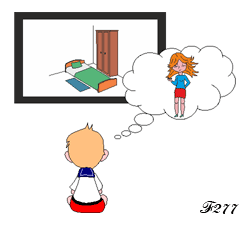
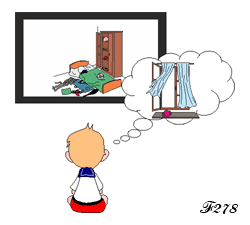 |
In a similar experiment, this time with 7- and 12-month-old babies, Karen Wynn and her team showed them animations in which a person or a ball moved through a set of objects and changed their arrangement. They found that when the ball created order, the 12-month-olds looked at the scene longer than in other situations, showing their surprise. In contrast, the 7-month-olds paid the same amount of attention to all the animations.
They were thus able to deduce that although babies have an early intuition that objects cannot create order, they do not yet have it at 7 months.
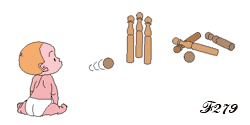 |
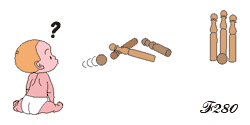 |
Disordering. |
Putting things in order. |
It remained to be seen what part the innate and the acquired play in the understanding of the link between the ordering of things and the need for an agent endowed with intention.
A third experiment showed that this ability is not the result of learning. Indeed, one-year-old babies possess it even if they have been familiarised with situations in which objects create order (e.g. a remote-controlled cube with hidden wheels will line up other cubes).
It is also known that babies distinguish order from disorder and agents from inanimate objects from the age of three months, which may be surprising given that they do not manage to explain this relationship until they are three to six years old.
A long period of time is therefore necessary for intuitive knowledge, perhaps innate, to be completed by social knowledge.
« There is a primitive knowledge of the world in the child which is based on the senses.
This knowledge imposes itself even though verbal language is incapable of explaining it. »
This knowledge imposes itself even though verbal language is incapable of explaining it. »
E – Consciousness and the self :
a – The place of the child in the evolution of the conscious self :- The self in the course of evolution:
For Professor Antonio Damasio, professor of neuroscience, neurology and psychology, the self is a dynamic process that appears and evolves in living beings. The mental activity that gives rise to it is generated in the neural networks that exist in all organisms with a sufficiently complex nervous system.
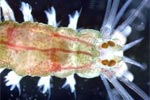
The annelid worm Platynereis dumerilii.
Initially, the function of these networks was to regulate the homeostatic balance of the organism. To do this, they had to be able to differentiate between the inside of the organism, i.e. what is self, and the outside, which causes unbalancing effects.
Later, after millions of years of evolution, these same nervous networks acquired the ability to create neuronal representations of the body and to perfect action strategies (foraging, flight, combat) aimed at maintaining homeostasis.
We can then speak of the primordial Self or protoself.
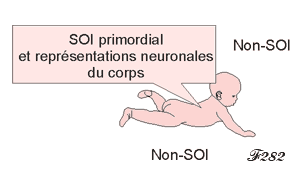 |
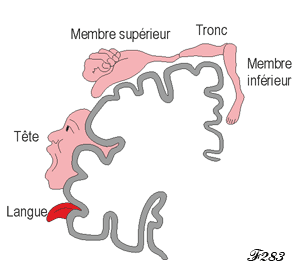 |
The perception of the primordial Self is linked to the existence representations of the body in the brain. |
Neuronal representations of the body in the brain. (Penfield's Homunculus) |
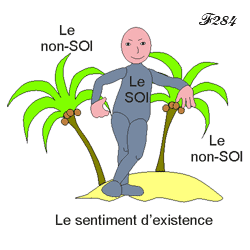
- Primordial feeling and homeostasis :
The primordial feeling, which consists in perceiving one's own body, is the first of all conscious states. Related to the limits of the body that define us, it determines what is Self by excluding all that is Other.
How did the evolution take place?
The structures of the brain stem that allow the perception of the body are at the origin of the protoself. It is in fact the perception of all external stimuli that gives rise to the consciousness of this body.
In addition to the sensation of the 'present and living' body, there is the sensation of the body being modified by the outside world, a sensation that can be interpreted as 'awareness of an outside world'. Indeed, we only feel the world through the sensations it produces on our body and its internal functioning.
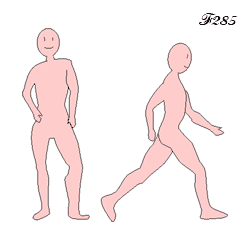 |
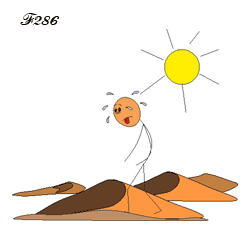 |
Sensation of the body present and in action. |
Sensation of the body through the effects produced by the environment. |
This external world will become "real" when other regions of the brain give it form.
- Appearance of the feeling of a personal thought :
At what point can we determine that a thought is our thought and not that of an external agent?
This sense of belonging appears at the same time as the sense of the personal body.
From the moment when the Self perceives the modifications of its body caused by a memory, the sensation of the moment, the project to come or the thought of its own death, the perception of all these elements creates emotions and feelings, which allow it to locate and separate the contents that belong to it from those that belong to the Self of others.
The feeling of a personal thought would thus appear at the same time as the feeling of the personal body.
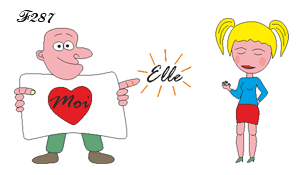
- The place of the Self :
Yet, although sentient perception is largely represented at the level of the cortex, and the development of conscious processes is observed at its surface [see : Highlighting one of the networks of consciousness - in french], it is structures in the brainstem, and more particularly the parabrachial nucleus and the nucleus of the solitary tract, that are the first to give rise to feelings.
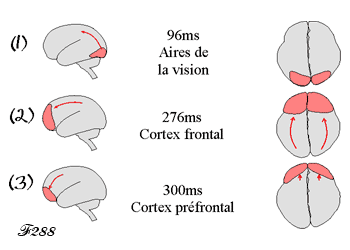
Development of conscious processes in the cortex.
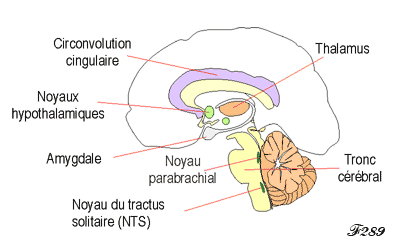
Structures underlying consciousness in the brainstem.
Indeed, lesions of the cerebral cortex, the presumed seat of consciousness, do not prevent the conscious perception of the environment and the manifestation of conscious states.
Similarly, bilateral lesions of the insula, a region of the cortex involved in processing a wide variety of emotions and feelings, do not prevent patients from experiencing pain, pleasure, and even feelings about others.
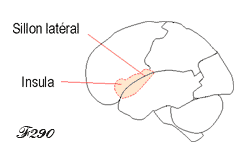
b – The place of the brain stem in the evolution of consciousness :
It is known that some children born without a cerebral cortex also exhibit behaviours that are generally attributed to consciousness. Despite the absence of a cortex and even of neurological structures such as the thalamus or the basal ganglia, they laugh when tickled, smile when they see toys, are happy in the presence of their mother, like or dislike certain pieces of music. Their bodies express life and interact with the world around them. They can be said to possess a form of self-awareness consistent with that of other babies.
In contrast, adults with an intact cerebral cortex but damage to small areas of the brain stem often lose the ability to experience feelings, primordial or otherwise.
The brain stem, the primitive structure of the nervous system, thus appears to be the basis of the functioning of consciousness ; it reveals its true role, which is to know in order to act. The complexity of the brain stem is discovered in the upper stages, which are particularly developed in humans, but it cannot be said that this is a specifically human characteristic.
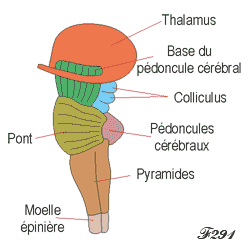
Anatomy of the brain stem.
What then of the child's thinking?
Adults refer to thoughts that escape their consciousness as 'unconscious'. They emerge from a cerebral activity of which only the final result reaches them [see : The unconscious generates its own thoughts - in french]. The adult has lost the ability to think directly with his primitive thought, but could the child not be conscious thanks to it (like all living species with a complex nervous system) ?
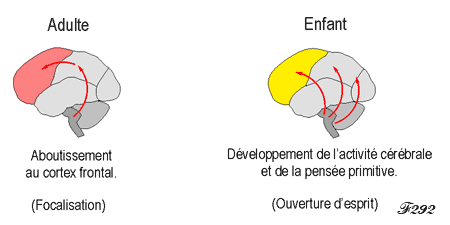
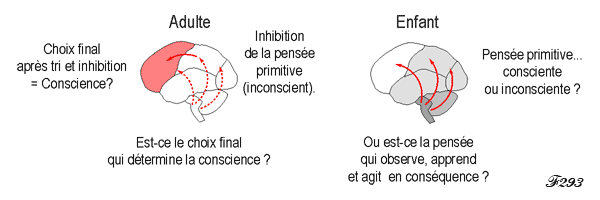
- The state of emptiness, which can be reached in certain meditation techniques during which the frontal cortex is put to rest, could then be understood as leading to the perception of existing otherwise.
- Concerning REM sleep, we could also understand that, during the dream, we function with this primitive thought which works in us and of which we are then conscious... until the moment when our inhibiting daily thought erases all memory of it on waking !
Consciousness therefore seems to be able to do without the most recent and most accomplished structures of our brain: it would then depend only on tiny regions of the brain stem capable of listing information and collaborating to make consciousness emerge.
This raises the question of what the intelligence and consciousness of mammals, reptiles and insects might be.

As far as cells are concerned, we know the extraordinary capacities of DNA [see : DNA and memory - in french], and we know that the cells, whose construction and functions it organises, can assemble and collaborate by the billions to elaborate so many totally different organisms, mobile, intelligent, and perfectly adapted to their environment.
If we consider the Earth as a gigantic organism in which each individual participates in the common life, we can compare the human being to a neuron that weaves its web to access the global consciousness of the world in which it lives.
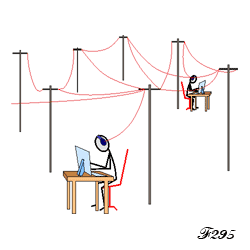 |
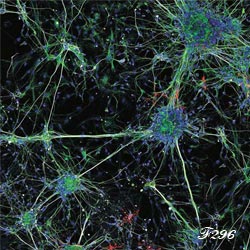 |
But today, man's individual consciousness is struggling to evolve into a collective consciousness capable of ensuring the mutations that are indispensable for his survival.
Evolution has proved that, with time, it can find a solution to all problems, but it has taken billions of years to do so.
During the development of the animal kingdom, such as that of the dinosaurs, it has sometimes had to rethink and innovate, in this case favouring the development of mammals.
As for the human species, time could be running out, unless it achieves a true collective consciousness that admits reality and not just the satisfaction of its desires.
« Adult human thought shows us at every moment the limits of its consciousness...
Would it be then the child's way of thinking that would open the access to Consciousness ? »
Would it be then the child's way of thinking that would open the access to Consciousness ? »
Fourth step towards dream interpretation : (continued)

